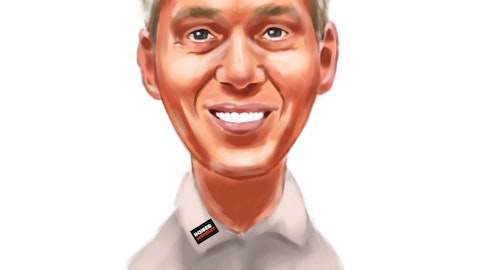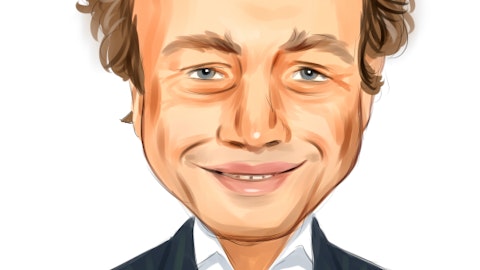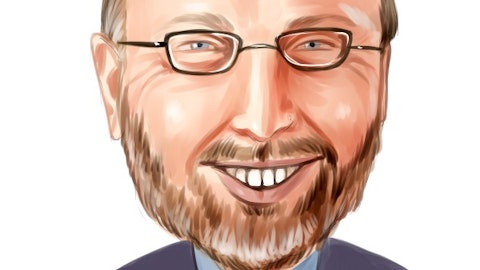David Spellman: Yes, so, Allie, thanks for the question. So like I said in the prepared remarks, we’re not going to provide the specific guidance, but we have done a lot of work to continue to bring down R&D and SG&A and we’ll continue to do so, even this quarter. A lot of that focus is, bring it down so that we can balance the Auryxia revenue and revenue growth with reinvesting in these pipeline opportunities. I think the big thing that I mentioned, the expectation to clear the going concern analysis, that is our, that’s the strongest guidance that we can give, that we plan to be able to manage our expenses within the cash that we have and the Auryxia revenue. So we’re very excited about that. And I think long-term the two things that would just factor into the burn would be success in the pipeline and to your point vadadustat investment in a commercial launch is not something that we’ve gotten our plan right now.
So if we are fortunate enough to be having those conversations, we would definitely be reassessing the investment plan. But again, this is where going back to something we haven’t talked about for a long time, our leverage and our commercial expertise, the model that we have right now, the focus on the dialysis center is — so the relationship in the dialysis center is so strong, and the relationship with Vifor to be able to partner with them on that potential launch, we don’t expect that this is a major, major new investment. We — leverage is going to be the name of the game there.
John Butler: Yes, it’s such an important point. And I mean, when we made the change to the commercial structure, it was with the thought of how to do that launch in mind as well, with the Vifor partnership, I mean, that would be incredible leverage we could get out of that organization. So yes, there is investment to be made in a launch, but in this case it’s not. It’s a very, very small investment in people, a couple marketing people maybe. But and we dust off a launch plan that we had a year ago and I think it would be, obviously it’d be a phenomenal outcome for us. But again, as Dave said, I mean, we’ve built our budget without, right? We want the company to have the discipline of — we want to drive to positive cash with Auryxia alone and a disciplined approach to spending. And the team has done a phenomenal job of delivering on that, and we expect to continue to deliver towards that in 2023.
Allison Bratzel: Got it. Thanks so much.
John Butler: Thanks Allie.
David Spellman: Thank you.
Operator: Thank you. And our next question is coming from the line of Ed Arce with H.C. Wainwright. Your line is open.
Ed Arce: Great. Thanks for taking my questions and congrats on all the operational progress in 2022 including the strong growth of Auryxia. First question from me, I noticed you mentioned you have signed a European license agreement with Averoa for Auryxia in Europe. I’m wondering if you could just discuss what you expect there? What kind of communications we can expect going forward with that? And what’s your expectations for the end of exclusivity in those markets?
John Butler: Ed thanks for the question. So Averoa is a small European company. And again, with Auryxia, we’ve only had the product available in the U.S. and the idea of bringing this to European patients where we think there can be a benefit has always been attractive for us. We — but we knew this is something we weren’t going to execute on our own. So bringing in a partner to look at this and look at it a little bit differently, they’ve got to look at the market just a little bit differently and they’re working on that now, and they’re consulting with regulatory authorities, and we tried to put a contract in place here that created upside for us if they’re successful with very, very little, I don’t say downside risk, but distraction for the organization.
And that was quite important. So again, we’re living our purpose of bringing products to patients where there’s a need, but doing it in a way that really just creates potential upside for us. Remember, in Europe, you have data exclusivity timeframe blanking on the amount of time it is, but that’s what they’ll be relying on rather than patent protection per stage in the market. So there’s an opportunity there. This is a deal that — obviously, a royalty-based deal for us. They are taking some risk, and we’re taking very little, but the upside is if they’re successful in the way they approach the EMA with this, so we’ll see. I wouldn’t say this is something that we put a significant amount of focus on as we think about building the company, but we’re happy with Averoa as a partner and look forward to supporting them as necessary.
Ed Arce: Okay. And then you also mentioned in the release that you’re working on certain initiatives to extend the revenues of Auryxia beyond March 2025. I wondered if you would care to expand upon that in any way? And perhaps related, I think I heard brief mention on your — in your prepared remarks of TDAPA. I’m wondering if there is any opportunity for you to leverage that come 2025? Thanks.
John Butler:
sevelamer:
sevelamer: But what’s unique to the situation we’re in today is, as you said, the TDAPA process that CMS has said that the phosphate binders will go into the bundle as of January 2025, which has been the expectation. But in the last final rule, they made that clear, and they made it clear that they were going to have a two-year TDAPA process, and I think a three-year TDAPA process, which they did for would be more appropriate and we’ll talk with them about that. But with a two-year TDAPA process, it means they’re collecting data for those two years to see how the dialysis providers utilize phosphate binders, so they can make a decision about what to — what dollar amount to add to the bundled payment come January of 2027. So if you think about this from a dialysis provider standpoint, there’s a lot of motivation to use.
Obviously, they treat patients appropriately, but to use products like branded products so that they’re not going to end up with a bundled payment that doesn’t cover their costs ultimately. So there is clearly an opportunity for us with Auryxia over the course of 2025 and 2026 to work with them on utilizing the drug appropriately for patients, of course, but increasing, continuing to increase the utilization and then helping with that switch over to generics beyond 2026. So there’s some really, I think, some meaningful revenue opportunities there, and we’re just now working with dialysis providers to see how that will be rolled out.
Ed Arce: Okay, great. And then one last question, I joined a bit late, so maybe you discussed this already, but I just wanted to clarify for vadadustat in the U.S. If that process were to ultimately result in an approval, commercially what is your plan right now?
John Butler: So the focus of the FDRR now is for patients, is for dialysis patients only. So that would be the expectation of what an approval would yield. And the commercial organization that we’ve put in place now, the reorganization we did late last year, we think from a field perspective, we probably have to add a couple of marketing people, but from a field perspective, we have what we need for that launch because of the Vifor relationship, right? We have the Vifor relationship that we have, where they have, we’ll sell directly to Fresenius and the other small and medium providers who have contracts, they have contracts with, really allows us to have a much more efficient commercial focus and delivers a tremendous amount of leverage for us on our P&L if we’re successful with that.
Ed Arce: Great, thanks so much.
John Butler: Thanks, Ed.
David Spellman: Thanks Ed.
Operator: Thank you. Our next question is coming from the line of Robert Hazlett with BTIG. Your line is open.



